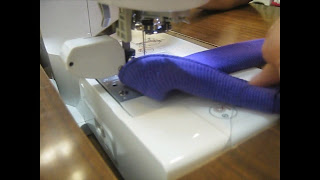Today we take a look at how to turn a corner while using an overcast stitch.
There is an easy way to turn a corner while you are sewing around the edge of a piece of fabric. Let me show you how.
Often when you are sewing you will find the need to change the direction of stitch without stopping and restarting the stitch. Whether it's an overcast stitch like in this case or just working with material that requires such action, there is an easy way to do it.
In this example we need to turn the corner with our overcast stitch.
When you get to the corner simply lower your needle into the fabric and raise your presser foot. Now you have a pivot point that you can easily turn your fabric on.
Make sure that you are in the spot that you want to continue sewing from. Because we are using an overcast stitch I want to make sure that after I turn the fabric I am the correct distance from the edge for my overcast. This way when I continue the next leg of sewing I will have a nice even and straight stitch.
 |
 |
 |
It's as easy as 1-2-3!
|
I hope you enjoyed this post. If you want to see this in action you can check out my video HERE. This particular action is at the 4 minute 13 second mark.


















































